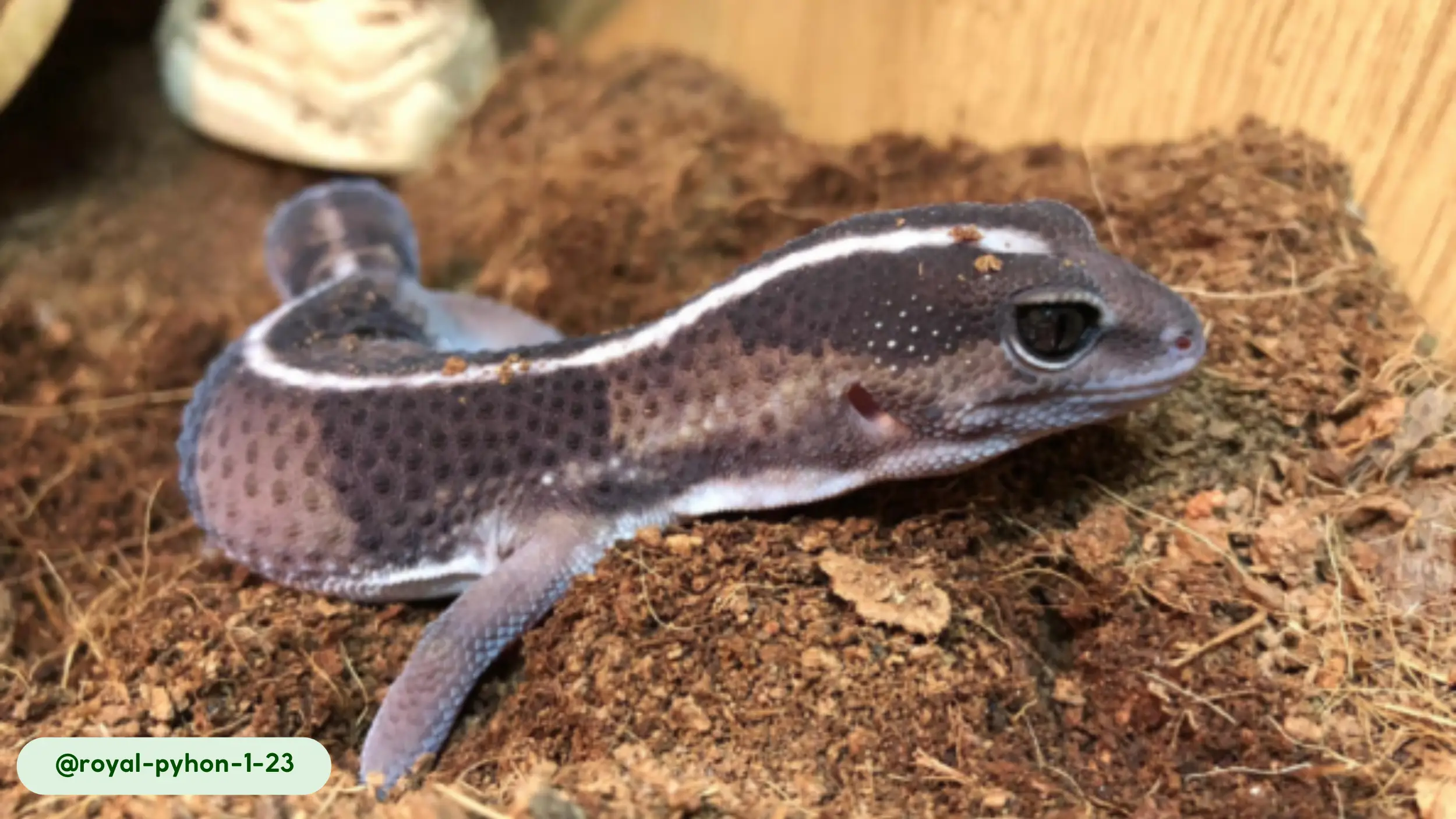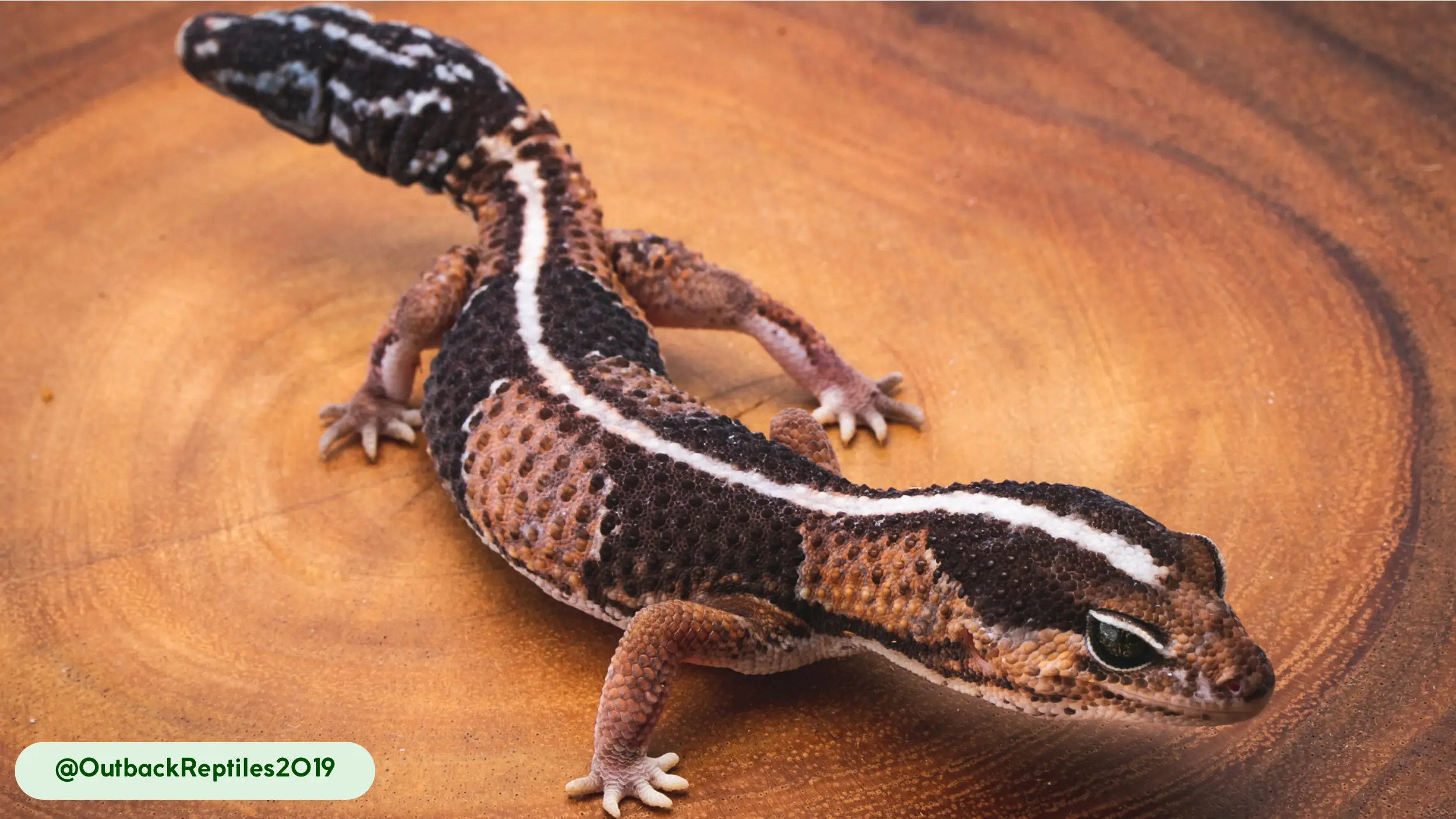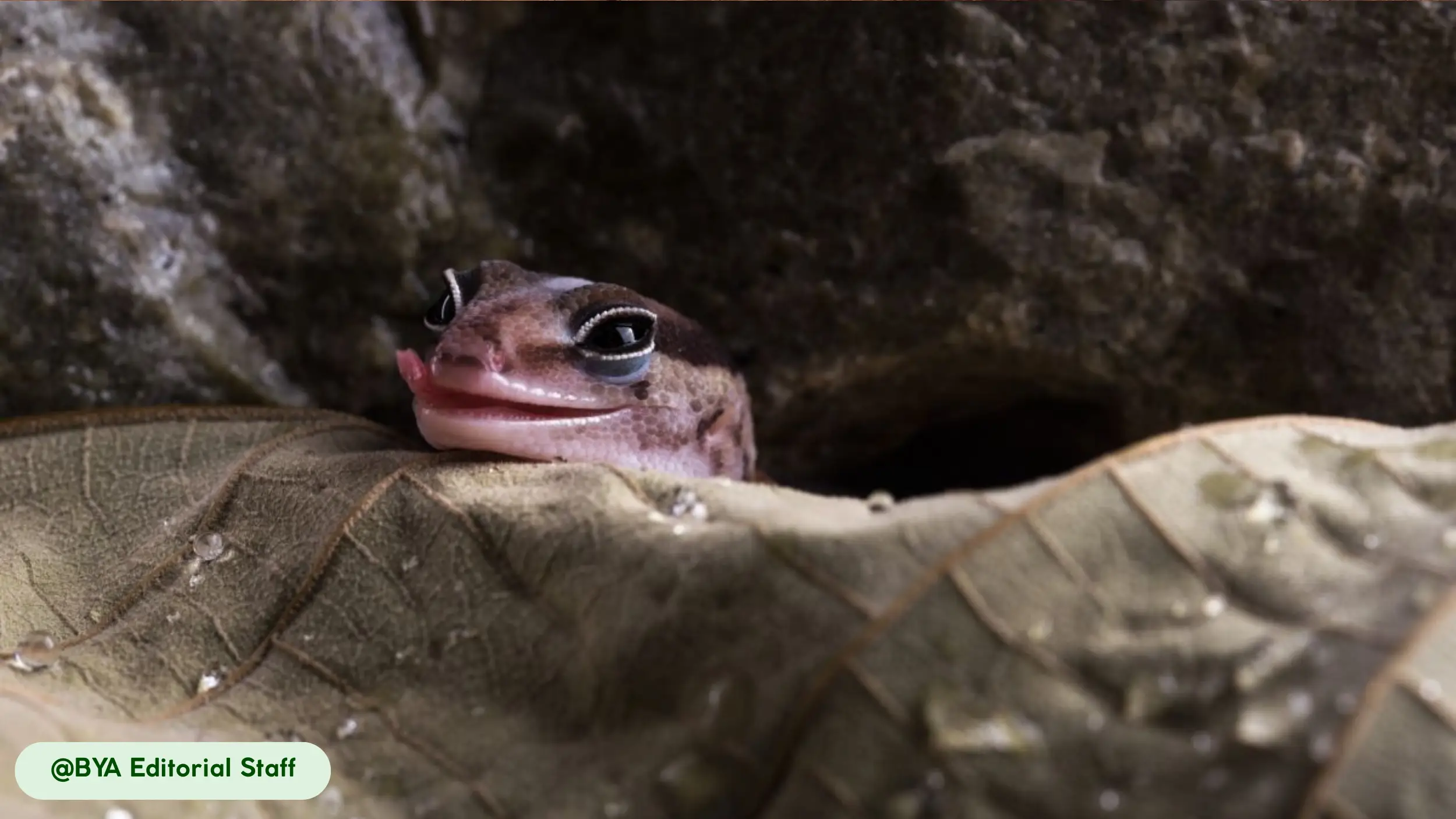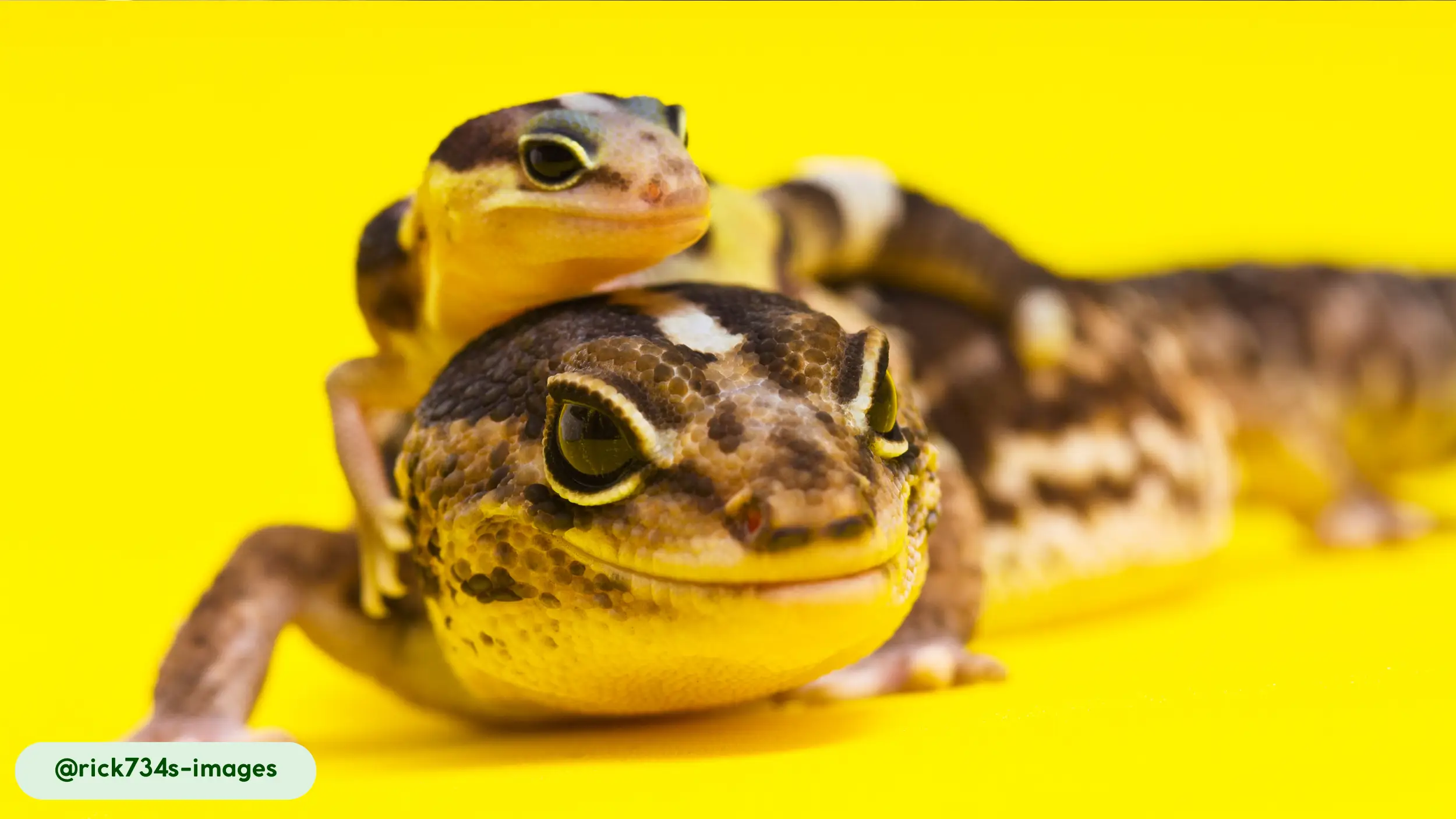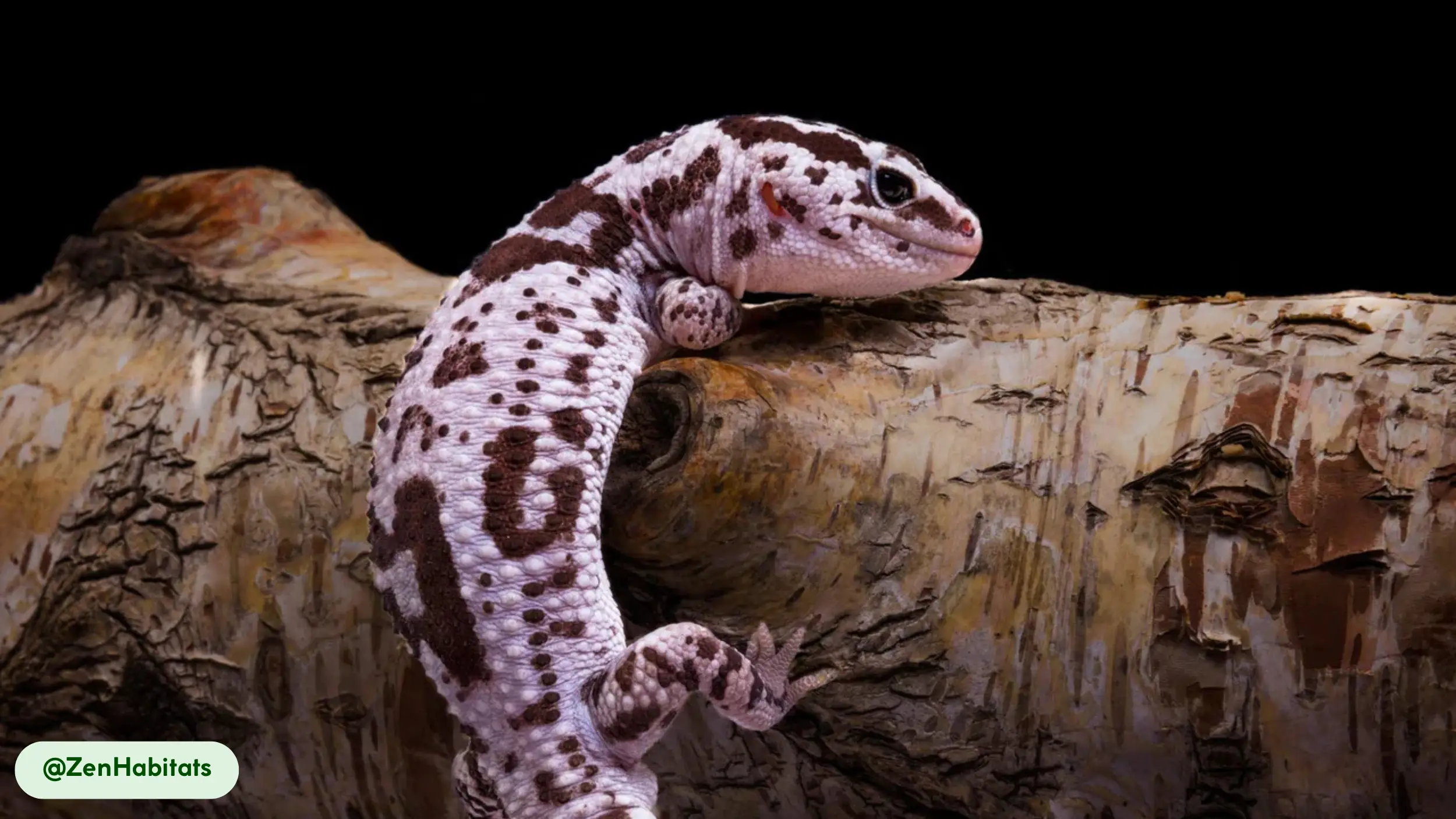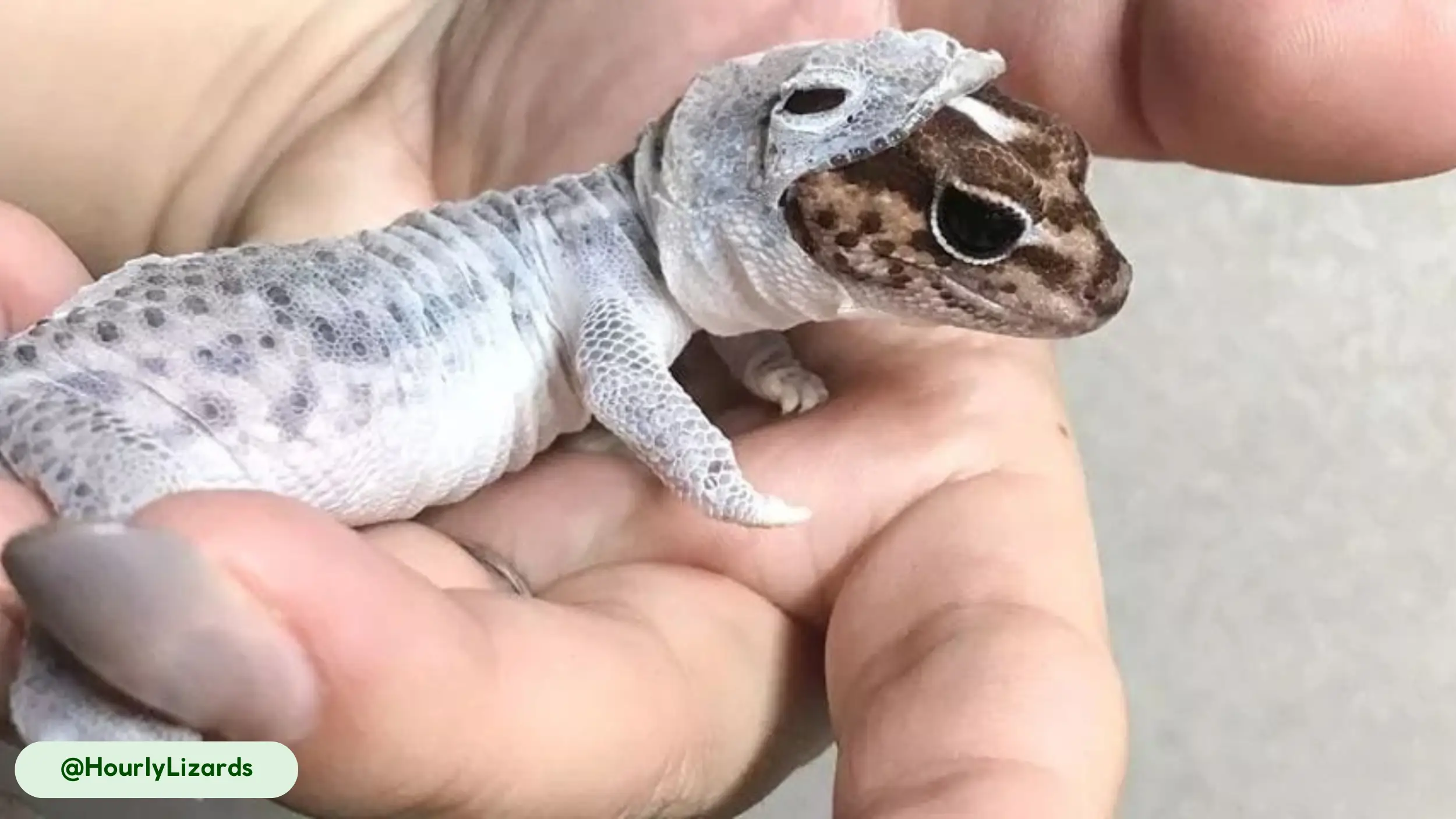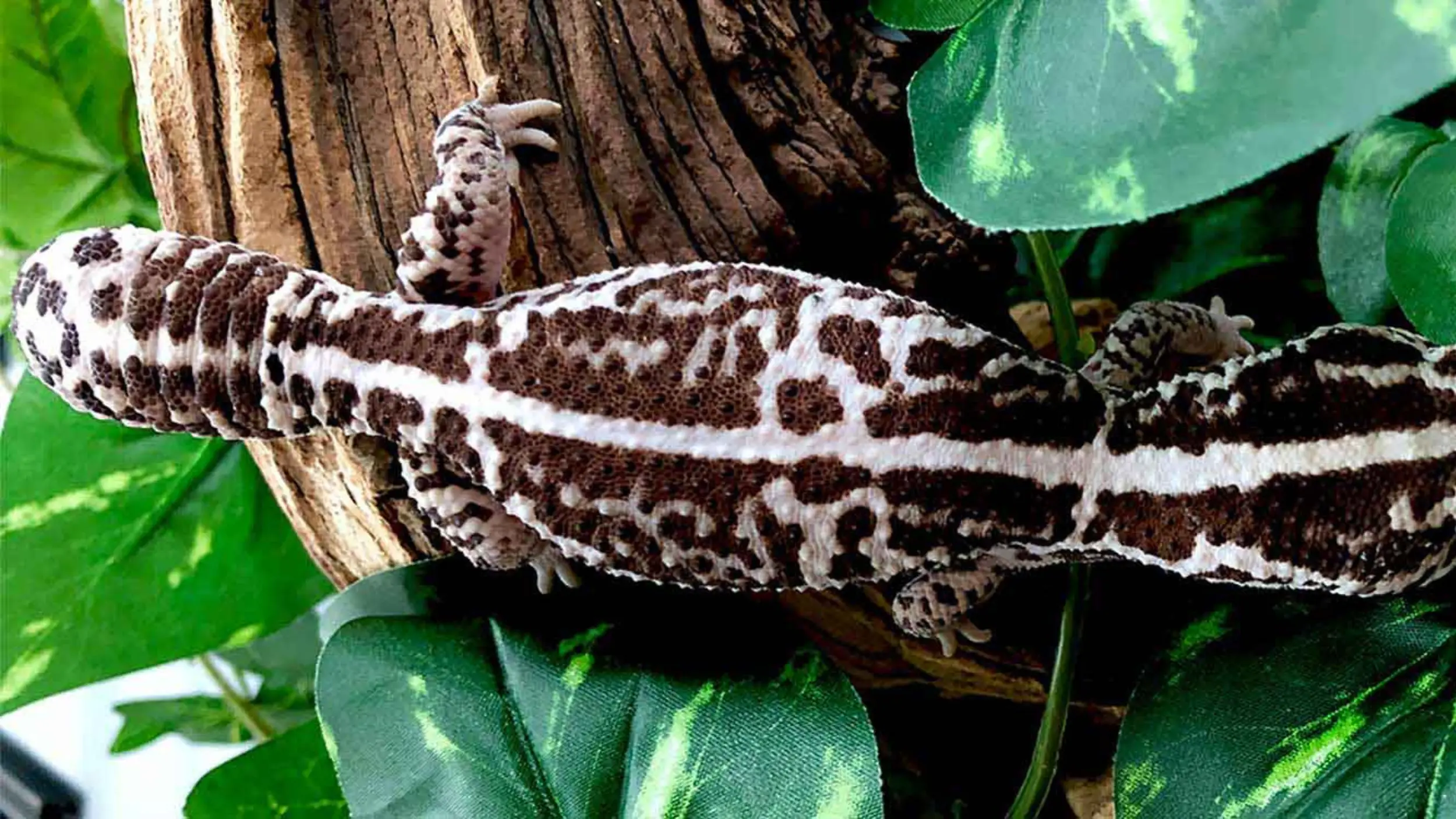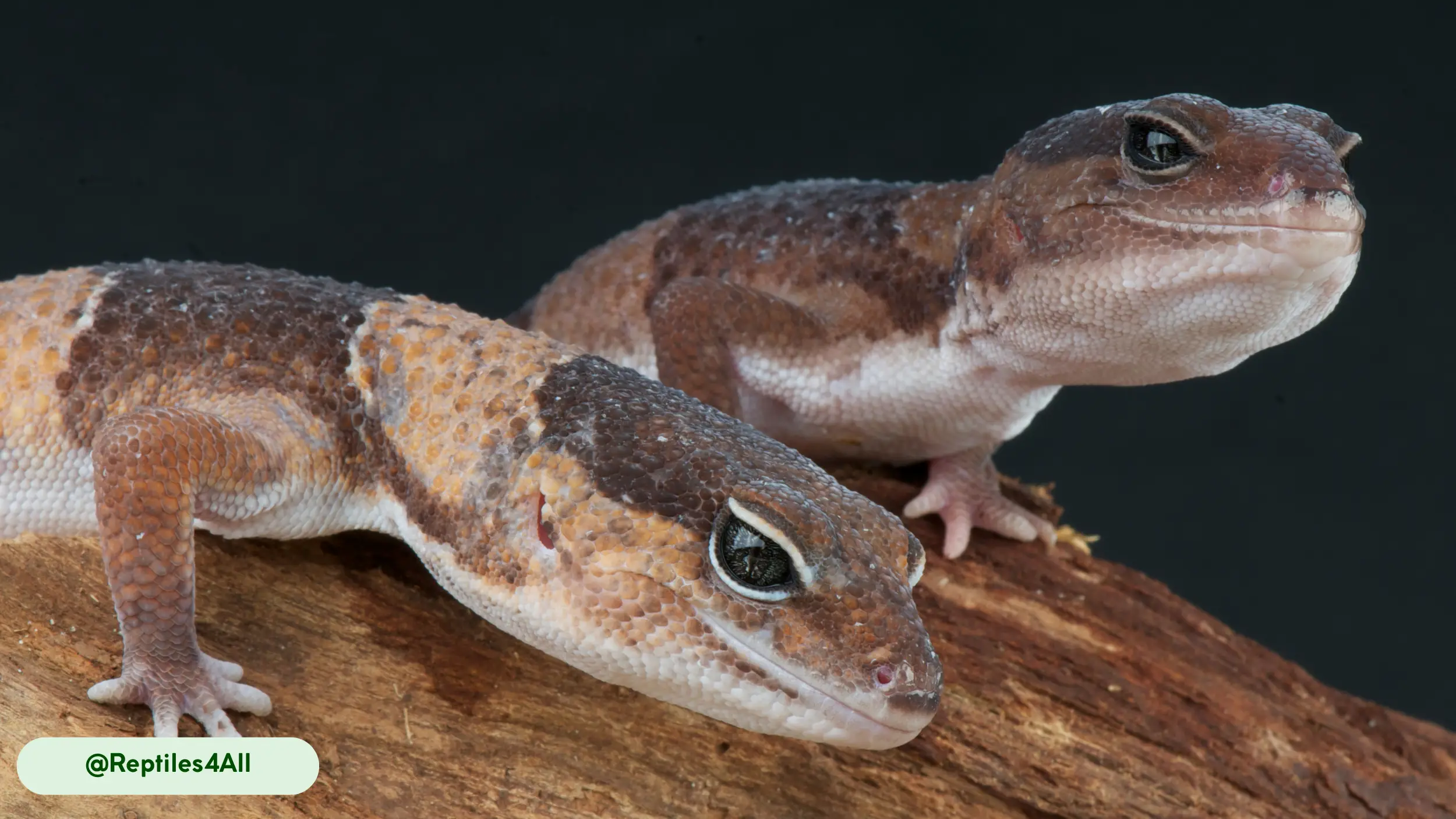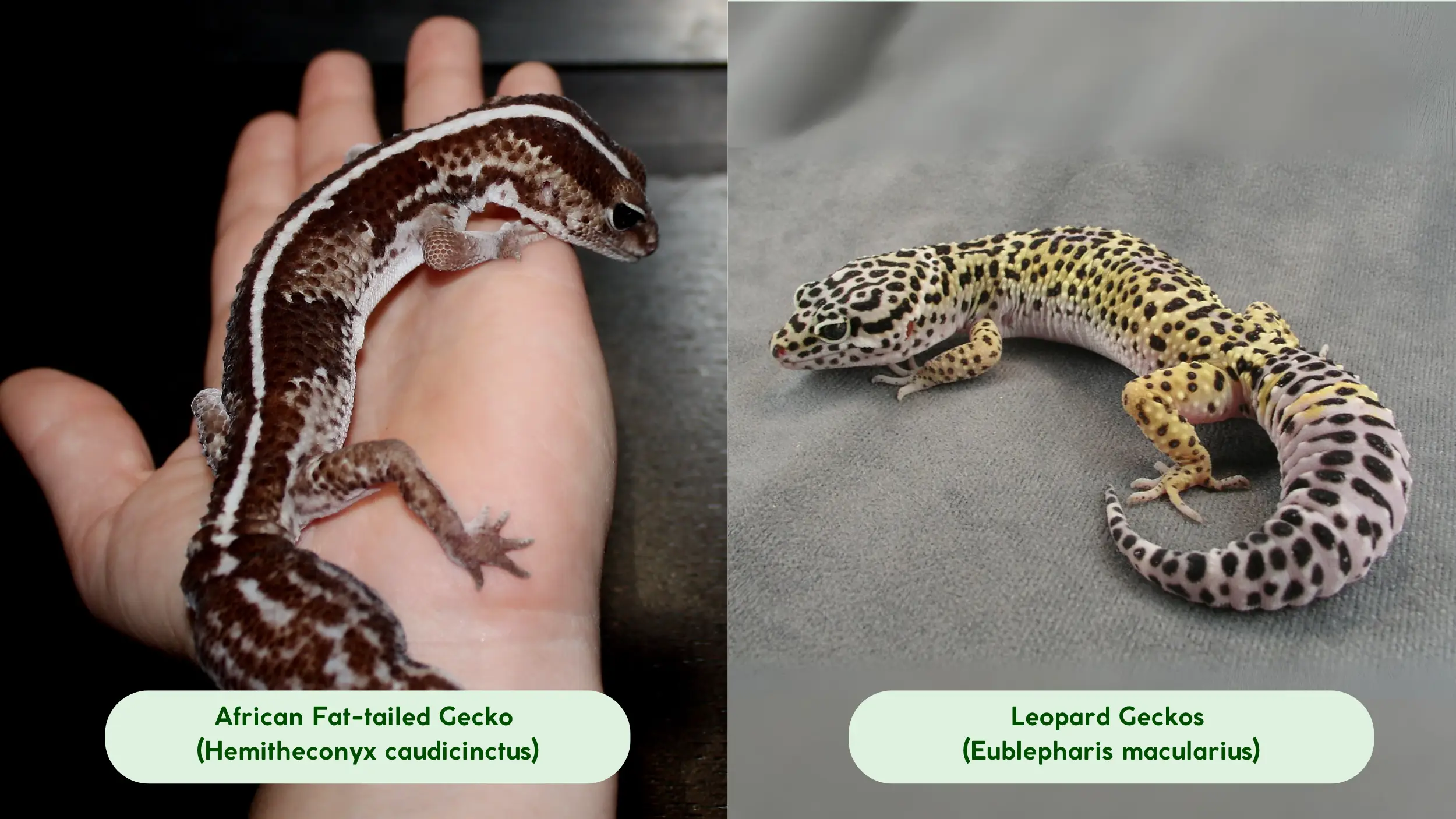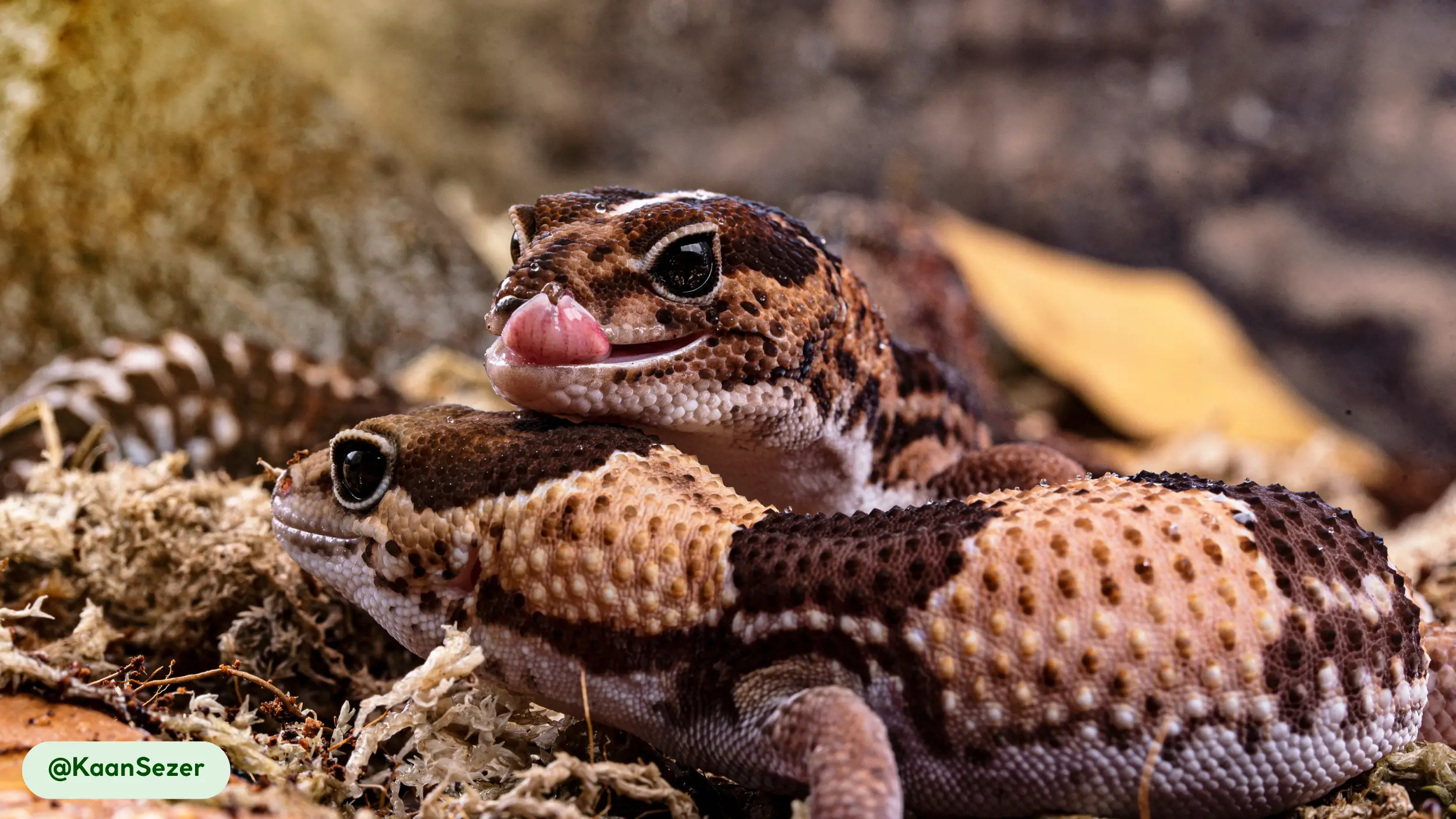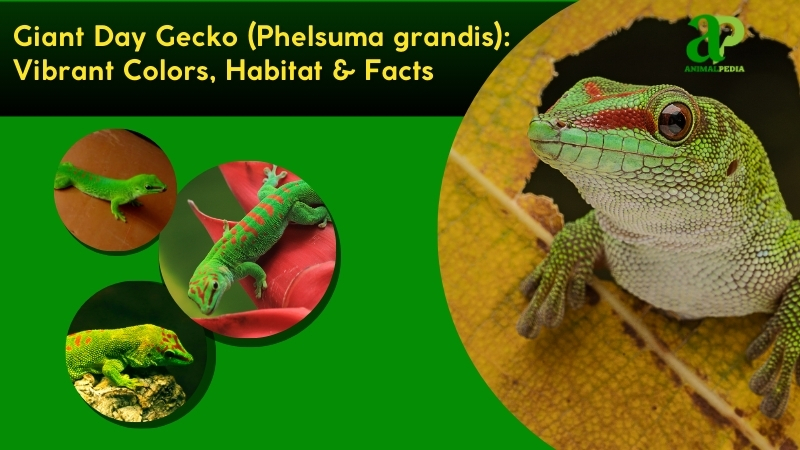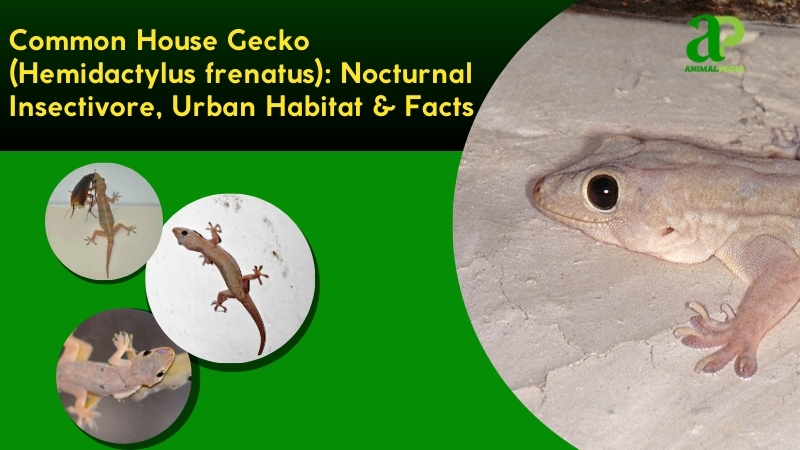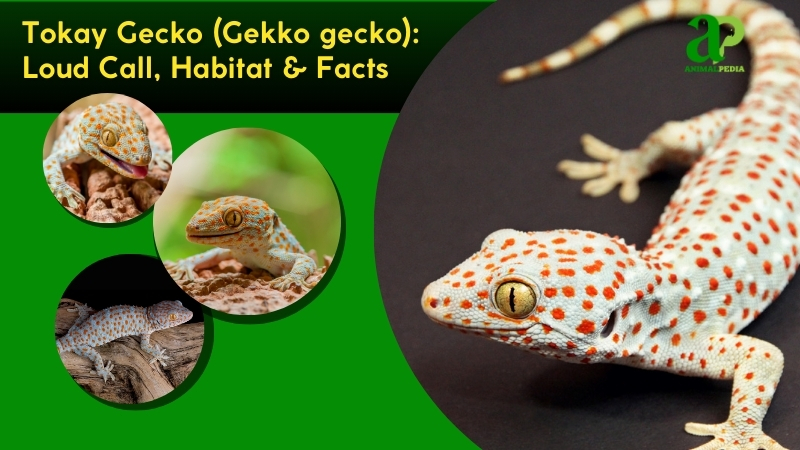African Fat-tailed Geckos, Hemitheconyx caudicinctus, are a species of reptile known for their docile temperament and distinctive anatomy. Native to the dry savannas and woodlands of West Africa, including Senegal and Mali, this species has adapted to its arid environment by developing a tail that stores fat reserves.
As a member of the Eublepharidae family, or eyelid geckos, it is a ground-dwelling, nocturnal insectivore that primarily forages for crickets and roaches. The average adult measures 7-9 inches (18–23 cm) in length and weighs between 0.1 and 0.17 pounds (45–75 grams). Despite its popularity in the pet trade, the species remains listed as Least Concern by the IUCN Red List, reflecting a stable wild population [4, 11, 14].
To fully appreciate this reptile, a deeper understanding of its biology and place in its ecosystem is required. This guide explores the geckos’ physical characteristics, from their robust body shape to their specialized vocalizations. It also details their natural habitats and daily behaviors.
By providing this information, we provide context for this species’ role in its native environment and its interaction with humans. The African Fat-tailed Gecko is a species with a compelling story to tell, and it begins with its place in the animal kingdom.

What is an African Fat-tailed Gecko?
The African Fat-tailed Gecko, or Hemitheconyx caudicinctus, is a terrestrial gecko species native to West Africa, characterized by its stout body and thickened, fat-storing tail. Scientifically classified under the family Eublepharidae, this gecko is part of the order Squamata (lizards and snakes) and the class Reptilia [4, 14].
Its name derives from the Greek roots “cauda” (meaning “tail”) and “cinctus” (meaning “banded”), which describe its appearance. This reptile is also known as the Fat-tail Gecko or West African Fat-tailed Gecko, both of which point to its primary physical trait and geographic origin.
Phylogenetic analyses suggest that the African Fat-tailed Gecko diverged from its Asian relatives millions of years ago, a significant evolutionary split within its lineage [14].
Ongoing scientific debate surrounds the mechanism of gecko sex determination. Studies in 2024 and 2020 have provided evidence for Temperature-Dependent Sex Determination (TSD), suggesting that incubation temperature influences sex ratios [8, 9].
However, some researchers argue that genotypic components may also play a role, pointing to variability across populations and conflicting data within the Eublepharidae family [8, 9]. This discussion highlights the complexity of reptile biology and the need for further research to understand how these animals develop.
The African Fat-tailed Gecko is defined not only by its scientific name but also by its physical form. We will now explore the specific features that make this reptile so recognizable and well-suited for its life on the ground.
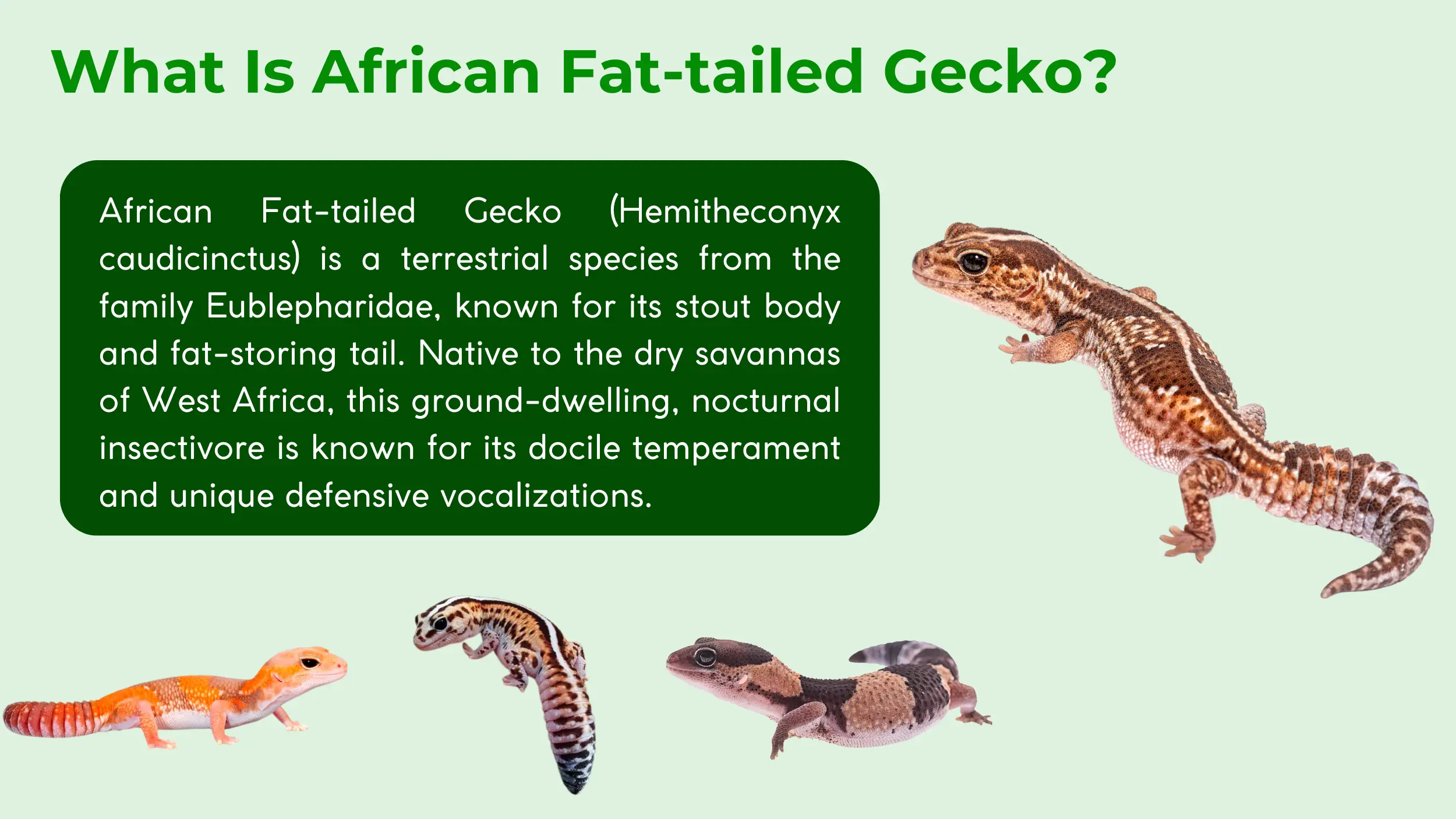
What Do African Fat-tailed Geckos Look Like?
The African Fat-tailed Gecko has a robust, somewhat squat body, well-suited to its terrestrial existence. Its physical form is marked by a light brown, tan, or orange-brown base color, with a pattern of darker brown transverse bands that provide effective camouflage within its native savanna and woodland environments.
A thin white or light stripe often runs along the dorsal midline, and the ventral surfaces are pale pink or off-white. The gecko’s skin is comprised of small scales that feel smooth to the touch, offering both protection and a low-friction surface for burrowing [4, 6, 14]. The species’ overall morphology is a direct reflection of its need to navigate, hide, and thrive on the ground.
This species has four prominent physical features that define its appearance and function.
- Broad Head and Large Eyes: The head is broad and flattened, triangular in shape, which aids burrowing. Their large eyes are golden or brown and equipped with vertical slit pupils for enhanced night vision, a crucial adaptation for a nocturnal predator. These geckos are unique among gecko species because they possess movable eyelids and a specialized, lizard-like nictitating membrane to protect the eyes [4, 6].
- Short, Sturdy Limbs: They have four short, sturdy limbs, each with five clawed toes. These claws are used for digging and gripping the substrate. Unlike many popular pet geckos, the African Fat-tailed Gecko lacks the adhesive lamellae on its feet, which limits its ability to climb vertical surfaces but supports its ground-dwelling lifestyle [4, 14].
- Thick, Bulbous Tail: The tail is the most distinctive feature, being short, thick, and bulbous. Its primary purpose is to store fat reserves, a vital adaptation for survival during periods of food scarcity in arid climates. The tail also assists with balance and serves as a defense mechanism through autotomy, or tail-dropping, to distract a predator [4, 6].
- Unique Defensive Vocalizations: Unlike the silent nature of many reptiles, African Fat-tailed Geckos can vocalize with squeaks or chirps, especially when threatened, offering a unique defensive trait [4, 14].
Sexual dimorphism is also evident in the species’ physical appearance. Males tend to be larger and more robust than females, with broader heads and more pronounced tail bases. Males also possess visible femoral pores and a hemipenal bulge at the base of the tail, which are absent or far less prominent in females [4, 6, 14].
The African Fat-tailed Gecko’s physical features give it a distinctive appearance, but its size is also a key factor in its biology. We will now examine the typical dimensions of this species and how its growth progresses from hatchling to adult.
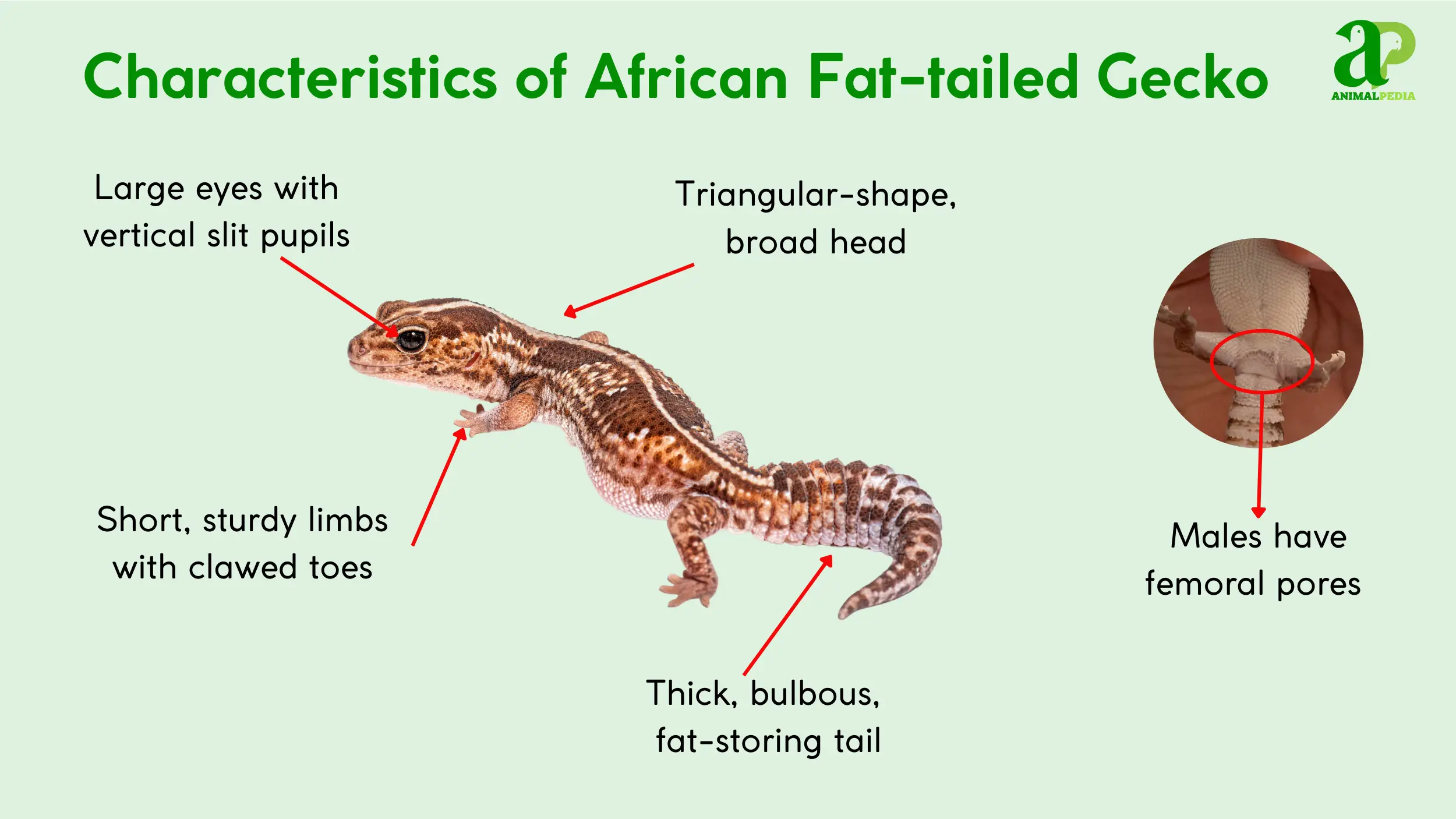
How Big Are African Fat-tailed Geckos?
The African Fat-tailed Gecko is a small- to medium-sized lizard. Adult geckos typically reach a total length of 7–10 inches (18–25 cm) and weigh between 0.09 and 0.2 pounds (40–90 grams). Males are generally larger than females [6, 11]. Their growth trajectory begins at birth, with a tiny size that increases as they mature.
| Feature | Male | Female |
| Length | Up to 10 inches (25 cm) | 7–8 inches (18–20 cm) |
| Weight | 0.1–0.2 pounds (45–90 g) | 0.09–0.14 pounds (40–65 g) |
Hatchlings are quite small, measuring only 2–3 inches (5–8 cm) long and weighing 0.004–0.01 pounds (2–5 grams). They grow into juveniles, reaching 4–6 inches (10–15 cm) in their first year. By 12–18 months, they reach full size and sexual maturity. In comparison, an adult gecko is roughly the length of a standard ruler.
While size is a constant physical characteristic, the gecko’s environment is the foundation for its existence. Its dimensions are a direct result of its evolution in a very specific part of the world, a place with unique challenges and resources.
Where Do African Fat-tailed Geckos Live?
African Fat-tailed Geckos are native to West Africa, inhabiting the arid and semi-arid savannas and woodlands of countries such as Senegal, Ghana, Togo, Mali, and Nigeria [4, 14]. This terrestrial species is a ground-dweller that seeks refuge in burrows or rock crevices to avoid the daytime heat.
Their preferred climate is warm and dry, and they thrive in microhabitats with adequate humidity [11, 14]. Geckos are solitary and territorial, with males actively defending their territories from other males to secure resources and mates [4]. This territoriality is a core aspect of their social structure.
Beyond its physical home, the African Fat-tailed Gecko’s survival is dictated by its daily behaviors and habits. These actions, from feeding to movement, are fine-tuned to help it thrive in its native landscape.
How Do African Fat-tailed Geckos Behave?
The African Fat-tailed Gecko is a nocturnal, terrestrial predator whose behaviors are optimized for survival in its arid environment.
- Diet and Feeding: These geckos are insectivorous predators that ambush their prey in the wild.
- Movement and Abilities: The species is terrestrial, relying on short bursts of speed for hunting and escaping danger.
- Daily/Seasonal Patterns: They are active at night and spend the day sheltering to conserve moisture and energy.
A deeper look into these behaviors reveals how they survive in their native habitat.
Diet and Feeding
The African Fat-tailed Gecko is an insectivorous carnivore that consumes a variety of insects and other arthropods. Its diet in the wild primarily consists of crickets, roaches, beetles, and spiders [4, 6]. These geckos are ambush predators, using patience and stealth to capture their prey.
They stalk prey with their sense of smell and keen night vision, then strike with a quick, powerful lunge [14]. Their feeding patterns are opportunistic. They eat every few days, depending on the size of their meal, and rely on their fat-storing tail to sustain them during periods of food scarcity [4, 14]. This is a critical adaptation to their arid environment.
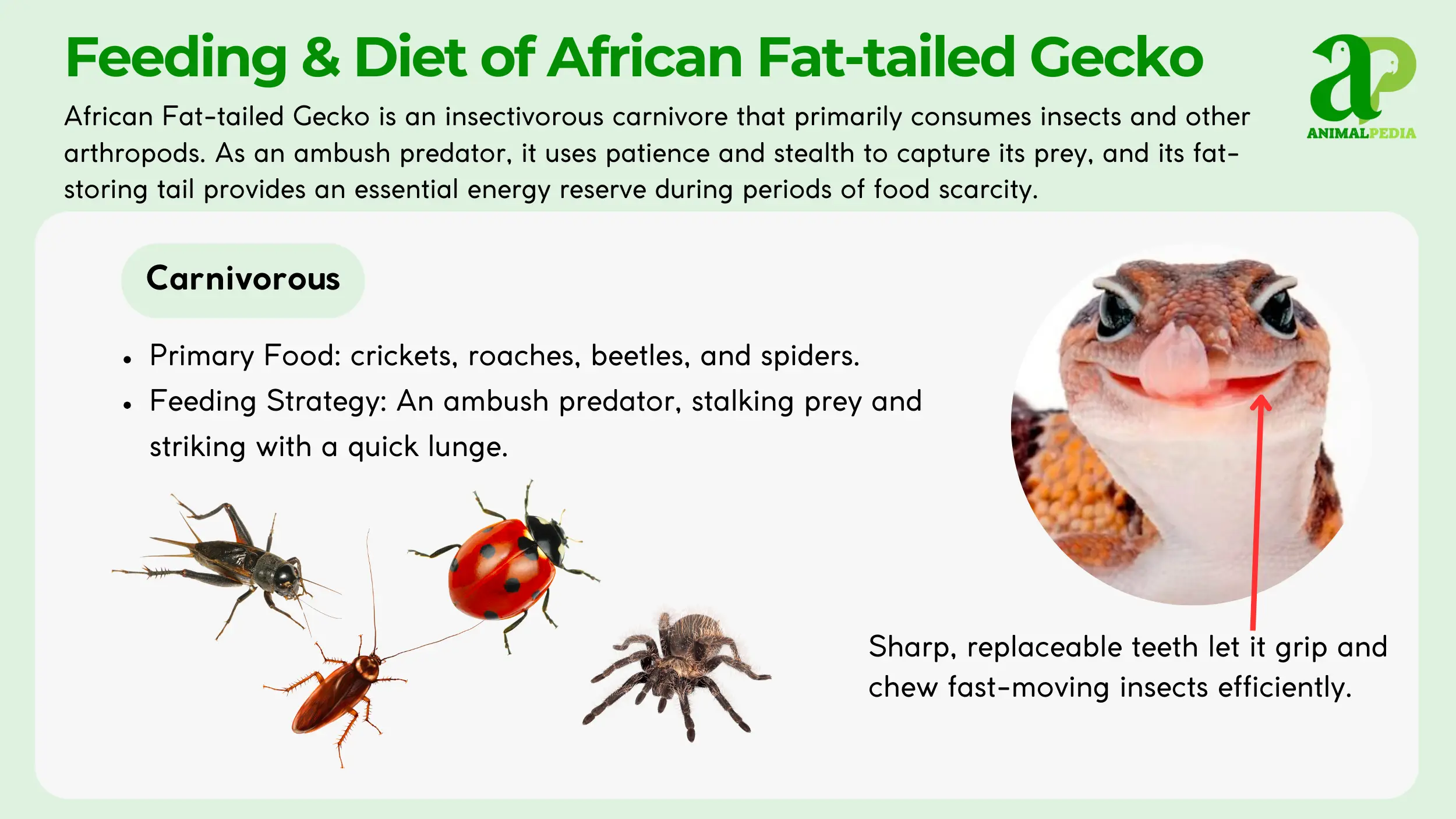
Movement and Abilities
African Fat-tailed Geckos are primarily terrestrial and move slowly and deliberately. They use their strong limbs to navigate their habitat. The species is capable of several types of movement:
- Walking: A slow, four-legged gait used for general movement and exploration.
- Running: Short, quick bursts of speed are used to catch prey or escape predators.
- Burrowing: Using their short, sturdy limbs to dig into soft substrate for shelter.
The species can reach speeds up to 10 miles per hour (16 km/h), though these speeds are not sustained [6]. The gecko has two special abilities that aid in its survival.
The first is tail autotomy, which allows them to voluntarily drop their tails when threatened. The detached tail will continue to twitch, distracting a predator while the gecko escapes [4, 6]. The second is a unique defensive vocalization, which includes a startling squeak or chirp to frighten potential threats.
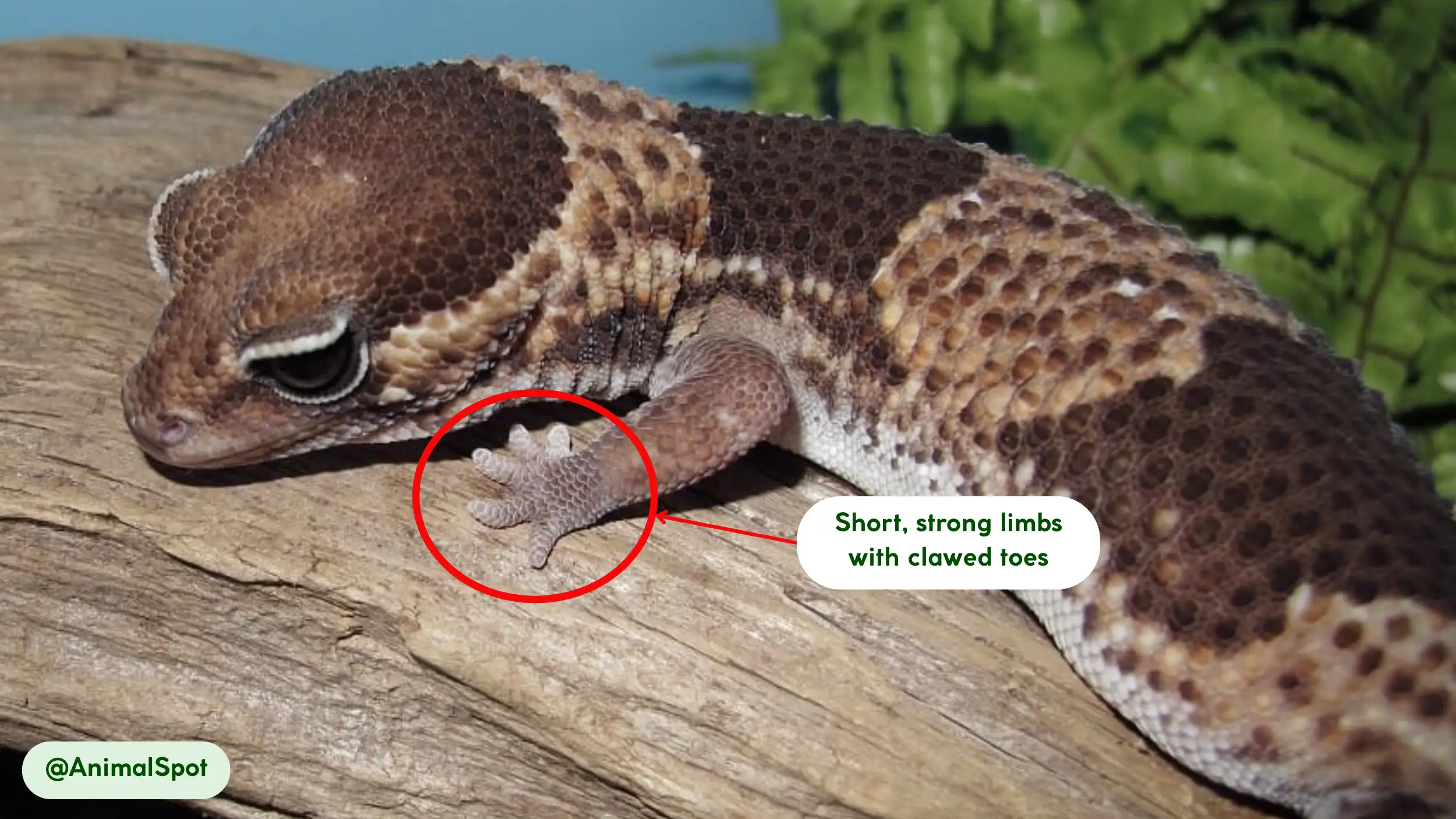
Daily/Seasonal Patterns
African Fat-tailed Geckos are strictly nocturnal. They are most active at night when temperatures are cooler and their insect prey is active. Their daily activity cycle follows a pattern of emergence and retreat to conserve energy and avoid the sun’s heat.
- Daytime (7 a.m. – 6 p.m): The gecko is inactive, sheltering in burrows or crevices.
- Dusk (6 p.m. – 8 p.m): They emerge from their shelters as the temperature drops.
- Nighttime (8 p.m. – 4 a.m): They actively forage for food and seek mates.
- Dawn (4 a.m. – 7 a.m): The gecko retreats to its shelter before the sun rises.
The geckos are more active during the wet season, which typically occurs from June to October. During this period, food is abundant, and conditions are ideal for foraging and breeding.
They may enter a period of brumation during the dry season —a state of reduced metabolic activity —to cope with food scarcity and cooler temperatures [6, 11]. These geckos do not migrate. They are highly localized and remain within a specific territory throughout their lives [4].
The gecko’s life is a cycle of survival, from foraging to seeking shelter. At the heart of this cycle lies its ability to create the next generation. A closer examination of its breeding habits reveals how this reptile continues its lineage in a challenging environment.
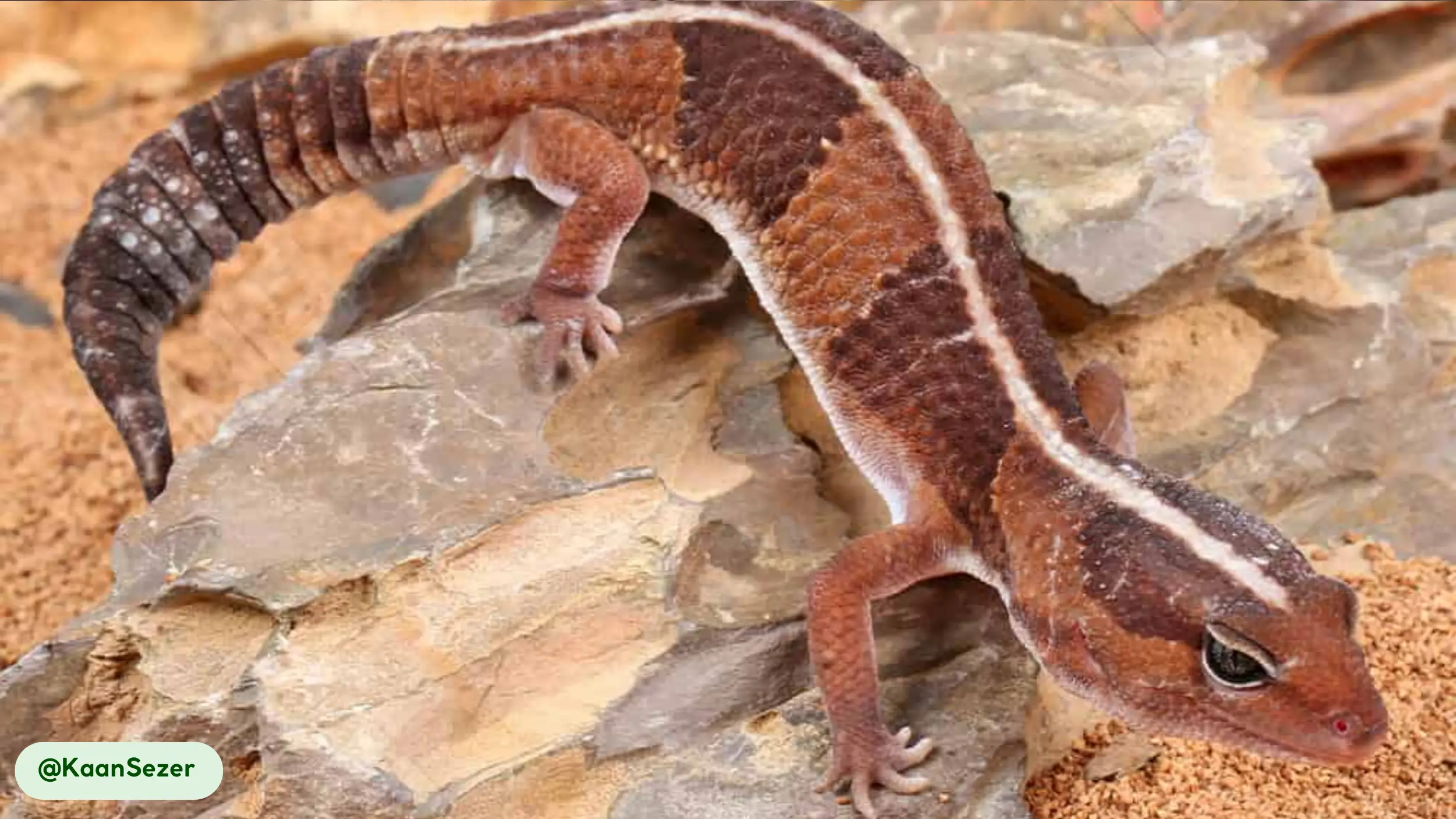
How Do African Fat-tailed Geckos Reproduce?
African Fat-tailed Geckos are oviparous, a reproductive strategy in which they lay eggs. Their breeding season aligns with West Africa’s wet season, typically from June to October. This period of increased humidity and abundant food serves as an environmental trigger for reproduction. Mating involves a courtship ritual in which the male approaches the female and performs specific tail-waving movements to signal his intent. If receptive, the female will allow the male to proceed with copulation.
Following successful mating, a female will lay a clutch of two eggs in a humid, protected location. She can produce several clutches during a single breeding season. The incubation period lasts 45-70 days, and studies indicate that the temperature during this phase determines the sex of the hatchlings [8, 9]. There is no parental care after the eggs are laid; the young emerge fully formed and are independent from birth, requiring no further parental support.
After a new generation is born, the question becomes how long these geckos can survive. The lifespan of a gecko is influenced by several factors, including natural predators and the conditions of its habitat.
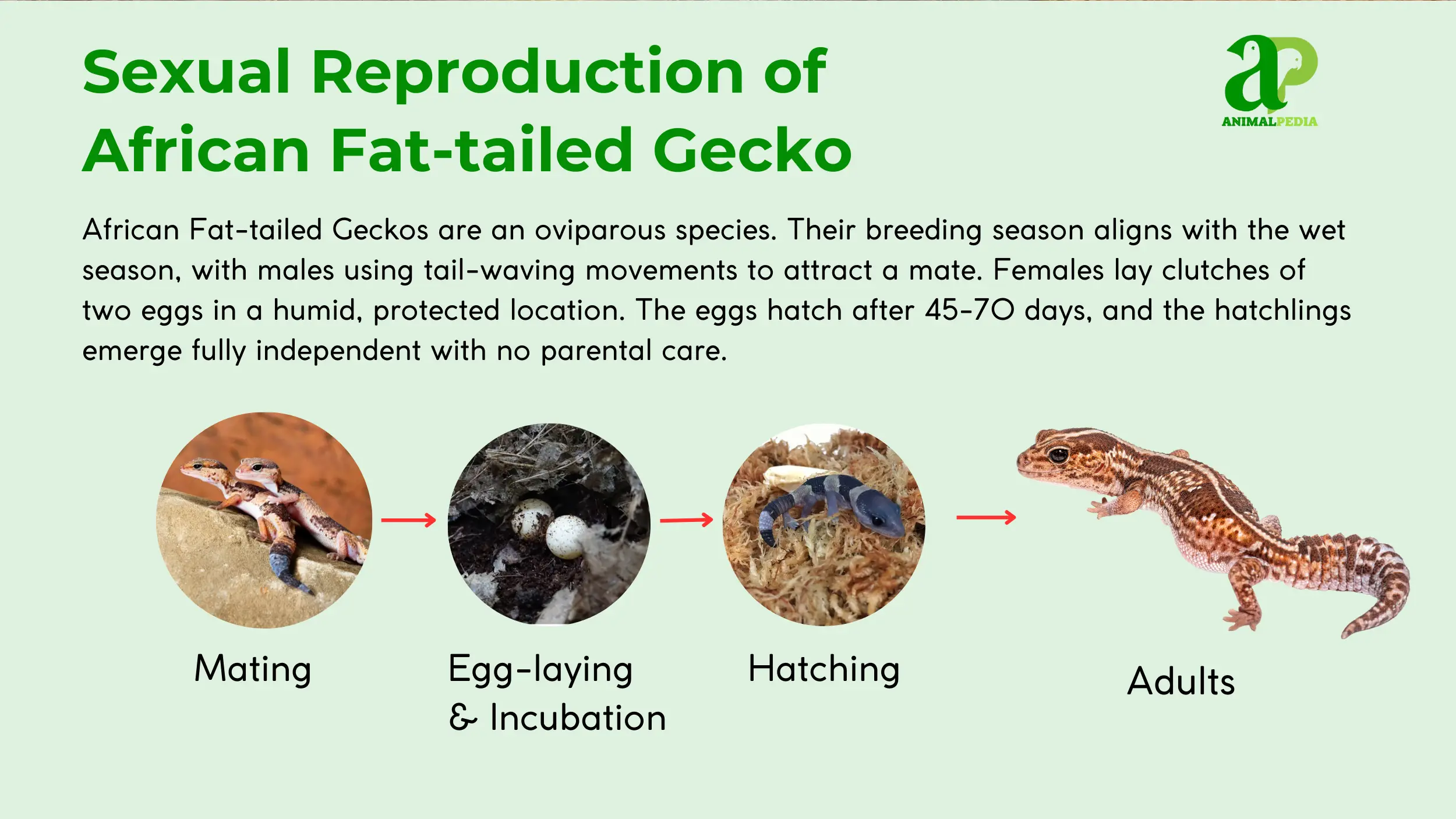
How Long Do African Fat-tailed Geckos Live?
African Fat-tailed Geckos live an average of 15-20 years in captivity. The lifespan of this species in the wild is considerably shorter, typically 5 to 10 years. This is due to factors such as predation, disease, and inconsistent food availability. Captive individuals benefit from a controlled environment, a consistent and nutritious diet, and access to veterinary care, all of which significantly increase their longevity.
These geckos reach sexual maturity at approximately 12 to 18 months of age, which marks the beginning of their reproductive period. An individual’s lifespan is influenced by several key factors. In their native habitats, they face threats from birds of prey, snakes, and larger mammals. Human encroachment and habitat destruction also affect their survival rates in the wild.
The gecko’s lifespan is one part of its story, but its relationship with other species, including humans, is another. This species has a significant impact on its ecosystem, a relationship that extends to us as well.
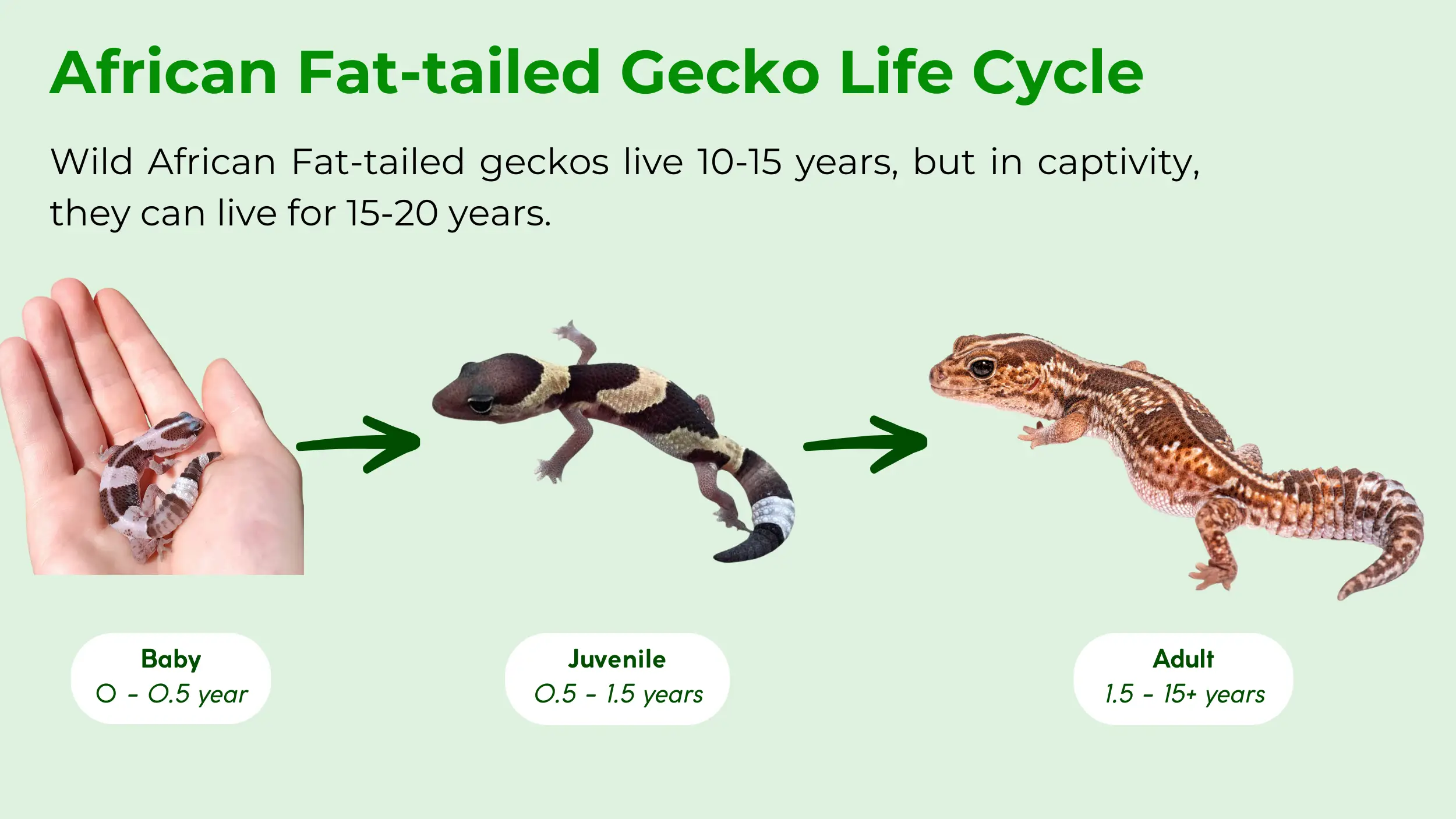
Are African Fat-tailed Geckos Harmful/ Beneficial to Humans?
African Fat-tailed Geckos are not considered harmful to humans. They are non-venomous and have a docile temperament, rarely biting unless seriously threatened. When confronted, their primary defensive behaviors are to drop their tail, vocalize with a small squeak, or defecate, all of which are non-injurious responses. Their small size and quiet nature make them a negligible threat in their native habitat and a popular choice among pet owners.
This species is beneficial to humans due to its diet. In the wild, they consume a variety of insects, including those that can be pests to crops and homes. This natural pest control benefits their ecosystem. They have no significant cultural impact on human societies. Instead, their role as a popular pet species highlights their harmless and attractive qualities to people worldwide.
The gecko’s role as a beneficial species is clear, but a more pressing question concerns its survival as a whole. Its classification on a global scale reveals its current standing and future outlook.
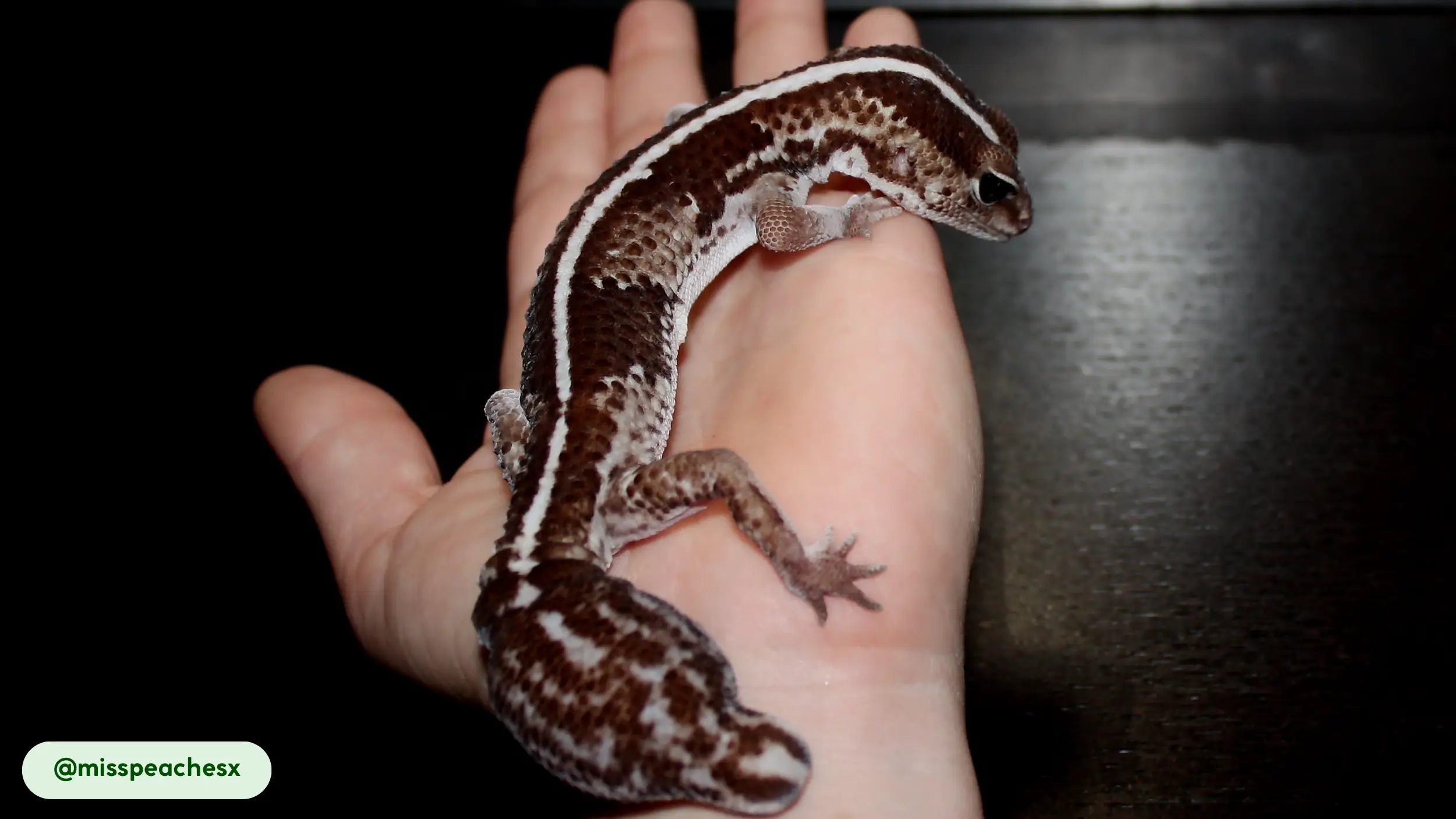
Are African Fat-tailed Geckos Endangered?
African Fat-tailed Geckos are not endangered. According to the IUCN Red List of Threatened Species, they are classified as Least Concern due to a wide distribution and a stable population trend [5].
While they do not face immediate extinction risks, certain threats do persist. Human activities such as habitat destruction and the illegal pet trade can affect local populations [13].
Despite these challenges, the species maintains a healthy presence across its native range. Their role as natural insectivores is crucial for maintaining ecological balance, as they help control insect populations.
Responsible reptile ownership, particularly by ensuring pets are bred in captivity rather than being sourced from the wild, contributes to the species’ overall sustainability and reduces pressure on wild populations. These individual actions are vital for the continued stability of this species.
With an understanding of the gecko’s status in the wild, we can now appreciate some of the more unique and surprising aspects of this fascinating reptile. There is always more to learn about a species.
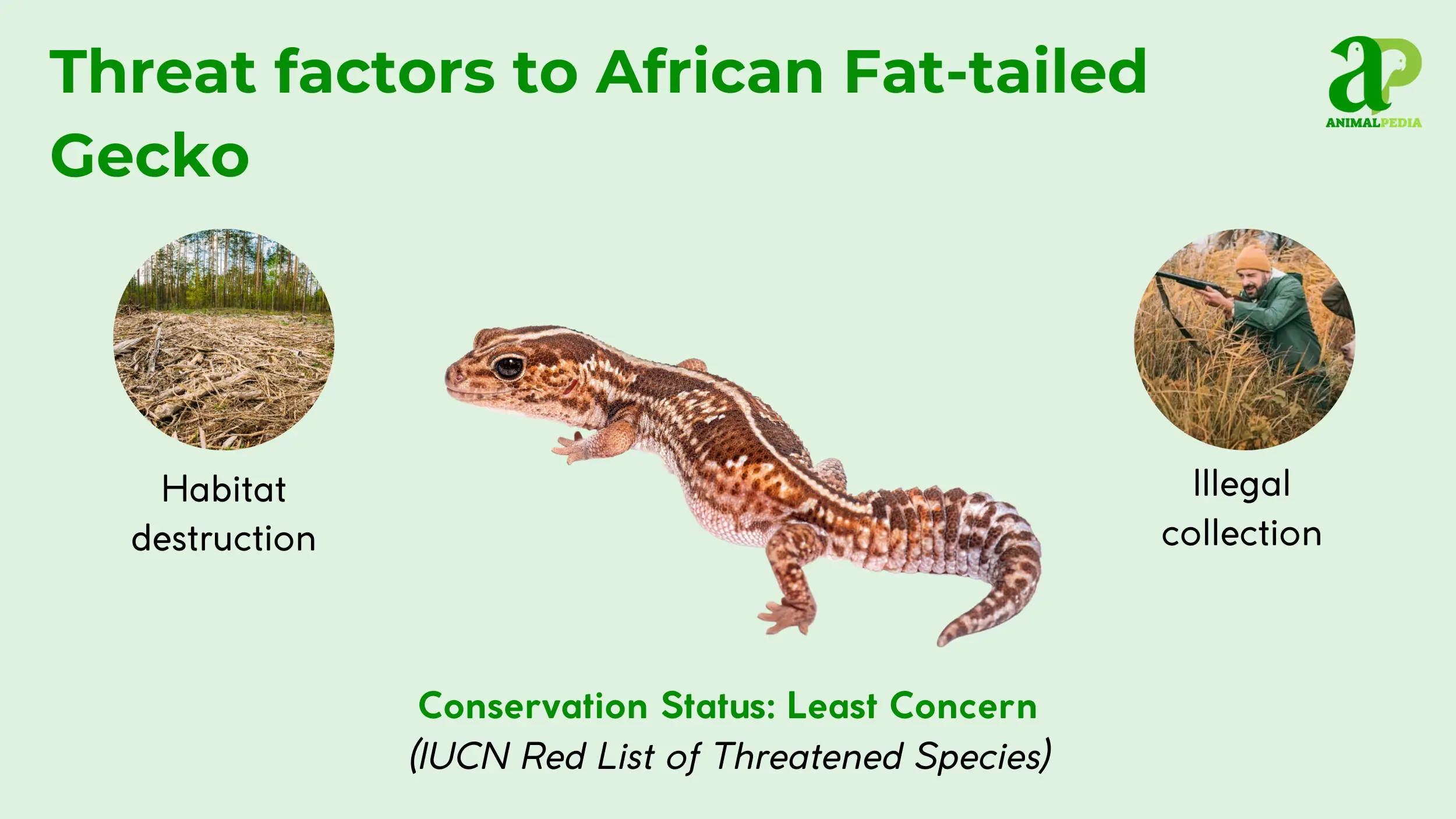
Frequently Asked Questions About African Fat-tailed Geckos
Are Leopard Geckos And African Fat-Tailed Geckos The Same?
No, Leopard Geckos and African Fat-tailed Geckos are distinct species, despite sharing some similarities. They originate from different continents and have key physical distinctions. The African species has softer skin and a shorter, thicker tail, while Leopard Geckos tend to be more active [6, 14].
Are African Fat-Tailed Geckos Good Pets?
Yes, African Fat-tailed Geckos are considered good pets, particularly for people new to reptile keeping. Their docile temperament, modest size, and relatively simple care requirements make them a suitable choice for a captive environment, where they can thrive and live for many years [6].
Are African Fat-Tailed Geckos Picky?
No, African Fat-tailed Geckos are not picky eaters by nature. They consume a variety of live insects, including crickets, mealworms, and roaches. Providing them with a diverse diet helps ensure their nutritional needs are met and supports their overall health [11].
Are African Fat-Tailed Geckos Poisonous?
No, African Fat-tailed Geckos are not poisonous. They do not have any venom glands or produce toxins. Their defense mechanisms are limited to non-injurious behaviors such as dropping their tail to distract a predator or vocalizing with a small squeak [4].
Do African Fat-Tailed Geckos Bite?
African Fat-tailed Geckos rarely bite. They are docile by nature and prefer to use other defenses, such as tail-dropping or squeaking, when they feel threatened. A bite is an act of last resort and is not a common behavior for the species [4].
Conclusion
The African Fat-tailed Gecko is characterized by its docile nature, distinctive fat-storing tail, and terrestrial lifestyle in the savannas of West Africa. Its unique adaptations for survival in a dry climate, from cutaneous hydration to defensive tail-dropping, highlight the species’ resilience.
At Animal Pedia, our goal is to provide a comprehensive understanding of animals like this through a lens of scientific precision and engaging content. For more detailed explorations of fascinating species, taxonomic insights, and advanced visual learning experiences, we invite you to continue your journey through our interactive digital encyclopedia.

